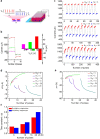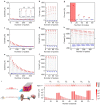Long-Term Homeostatic Properties Complementary to Hebbian Rules in CuPc-Based Multifunctional Memristor
- PMID: 27762316
- PMCID: PMC5071877
- DOI: 10.1038/srep35273
Long-Term Homeostatic Properties Complementary to Hebbian Rules in CuPc-Based Multifunctional Memristor
Abstract
Most simulations of neuroplasticity in memristors, which are potentially used to develop artificial synapses, are confined to the basic biological Hebbian rules. However, the simplex rules potentially can induce excessive excitation/inhibition, even collapse of neural activities, because they neglect the properties of long-term homeostasis involved in the frameworks of realistic neural networks. Here, we develop organic CuPc-based memristors of which excitatory and inhibitory conductivities can implement both Hebbian rules and homeostatic plasticity, complementary to Hebbian patterns and conductive to the long-term homeostasis. In another adaptive situation for homeostasis, in thicker samples, the overall excitement under periodic moderate stimuli tends to decrease and be recovered under intense inputs. Interestingly, the prototypes can be equipped with bio-inspired habituation and sensitization functions outperforming the conventional simplified algorithms. They mutually regulate each other to obtain the homeostasis. Therefore, we develop a novel versatile memristor with advanced synaptic homeostasis for comprehensive neural functions.
Figures



 means that more time is required to reach the respective saturated values in different modes.
means that more time is required to reach the respective saturated values in different modes.


Similar articles
-
Homeostatic Plasticity Achieved by Incorporation of Random Fluctuations and Soft-Bounded Hebbian Plasticity in Excitatory Synapses.Front Neural Circuits. 2016 Jun 1;10:42. doi: 10.3389/fncir.2016.00042. eCollection 2016. Front Neural Circuits. 2016. PMID: 27313513 Free PMC article.
-
Simulating Synaptic Behaviors through Frequency Modulation in a Capacitor-Memristor Circuit.Micromachines (Basel). 2023 Oct 29;14(11):2014. doi: 10.3390/mi14112014. Micromachines (Basel). 2023. PMID: 38004871 Free PMC article.
-
Organic Memristor-Based Flexible Neural Networks with Bio-Realistic Synaptic Plasticity for Complex Combinatorial Optimization.Adv Sci (Weinh). 2023 Jul;10(19):e2300659. doi: 10.1002/advs.202300659. Epub 2023 May 15. Adv Sci (Weinh). 2023. PMID: 37189211 Free PMC article.
-
Mechanisms of homeostatic plasticity in the excitatory synapse.J Neurochem. 2016 Dec;139(6):973-996. doi: 10.1111/jnc.13687. Epub 2016 Jul 1. J Neurochem. 2016. PMID: 27241695 Review.
-
[Acquiring new information in a neuronal network: from Hebb's concept to homeostatic plasticity].J Soc Biol. 2008;202(2):143-60. doi: 10.1051/jbio:2008018. Epub 2008 Jun 13. J Soc Biol. 2008. PMID: 18547512 Review. French.
Cited by
-
Biological receptor-inspired flexible artificial synapse based on ionic dynamics.Microsyst Nanoeng. 2020 Sep 7;6:84. doi: 10.1038/s41378-020-00189-z. eCollection 2020. Microsyst Nanoeng. 2020. PMID: 34567694 Free PMC article.
References
-
- Jo S. H. et al. Nanoscale memristor device as synapse in neuromorphic systems. Nano Lett. 10, 1297–1301 (2010). - PubMed
-
- Linares-Barranco B. & Serrano-Gotarredona T. Memristance can explain spike-time-dependent-plasticity in neural synapses. Nature precedings 1, 1–4 (2009).
-
- Prezioso M. et al. Training and operation of an integrated neuromorphic network based on metal-oxide memristors. Nature 521, 61–64 (2015). - PubMed
-
- Mahowald M. & Douglas R. A silicon neuron. Nature 354, 515–518 (1991). - PubMed
-
- Lai Q. et al. Ionic/electronic hybrid materials integrated in a synaptic transistor with signal processing and learning functions. Adv. Mater. 22, 2448–2453 (2010). - PubMed
Publication types
LinkOut - more resources
Full Text Sources
Other Literature Sources

